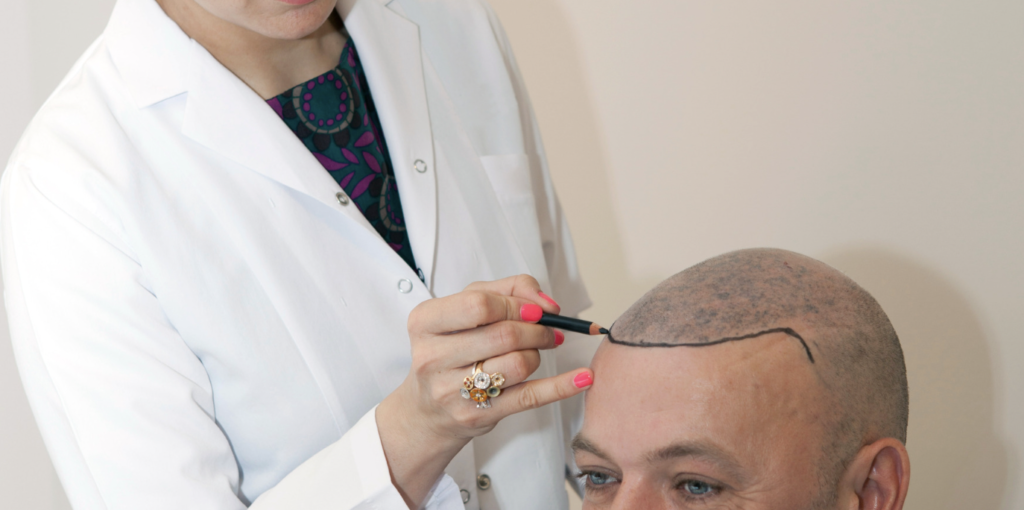You’ve heard knowledge is power, yes? Well, it helps to have all the facts when it comes to hair restoration. If this procedure is on your to-do list, you might wonder how to get the best hair transplant, FUE vs. FUT in Maryland?
If you are interested in hair transplant techniques, then this comprehensive guide is a must-read for you! We will exam what results to expect from the different methods. Additionally, what the cost of the different methods. The information can certainly help you make the most of your consultation.
Let’s Talk About Hair Transplant Techniques
There are two main types you need to know about – FUE (follicular unit extraction) and FUT (follicular unit transplantation).
With FUE transplant individual follicle harvesting two ways, with robotic assistance or manually. Many dermatologists prefer NeoGraft, as it is semi-automated and makes precision harvesting and transplanting not only possible but safe.
The healthiest and strongest follicles are harvested. This makes the efficacy of FUE quite successful. There is also no need to worry about scarring.
The FUE procedure itself takes about eight hours to complete. Recovery time is faster than with other methods, with many patients being able to return to normal activities within a few days.
During an FUT transplant, strips of hair from the donor area are harvested typically from the back of the head. This strip is then dissected into individual follicular units and transplanted into the balding or thinning areas of the scalp.
FUT is a manual surgical method that can take anywhere from four to 12 hours to complete. If you have limited hair in the donor area, this might be a viable option for you. However, there may be scarring, and it may be 10 to 12 days before you can resume normal daily activity.
How Can I Find Out Which Hair Transplant Technique Is Best for My Needs?
The easiest way to determine how to get the best hair transplant, FUE vs. FUT in Maryland is to schedule a consultation with a qualified doctor. It’s also a great idea to prepare.
During the meeting, you’ll go over quite a bit of information. It may seem a bit overwhelming, but rest assured it is all necessary for your safety and to ensure you achieve your desired outcomes. Be ready for the following:
- Evaluation: The surgeon will assess your hair loss pattern, donor area, and overall scalp condition. A physical examination of your scalp will be done. This is to assess hair density and scalp laxity.
- Medical history review: You’ll provide information about your medical history, medications, supplements, allergies, and any previous hair treatments you’ve tried.
- Discussion: The surgeon will explain the available hair transplant techniques in detail, including potential outcomes, side effects, risks, recovery, and expectations for each.
- Customized treatment plan: A personalized treatment plan, including the number of grafts needed and cost estimates, will be discussed.
- Question-and-answer session: You can ask questions about the procedure and address any concerns you may have.
- Photos: “Before” photos may be taken for documentation and to assist in planning.
- Preoperative instructions: You may receive instructions on preparation and lifestyle changes before the procedure. This may include adjusting or stopping certain blood thinning medications and not drinking alcohol in the days leading up to your procedure.
Post-consultation, you can schedule the surgery if you decide to proceed or take time to consider your options. If you do decide to go through with the treatment, you will be given consent forms to sign.
A Good Candidate for Hair Transplant Surgery Needs to Meet Certain Qualifications
You should be in good overall health with no medical conditions that could hinder healing. Ideal candidates have stable hair loss, sufficient donor hair, and realistic expectations. Most hair transplant recipients are above age 25. However, age of ideal patients can vary and is not set in stone.
How Long Does Recovery Take After a Hair Transplant?
The process requires patience as your scalp heals. It may take up to a year for full recovery and significant results. Your physician will furnish comprehensive post-transplant recovery instructions. You should follow these carefully.
Initially, expect side effects like redness, itching, scabbing, and tenderness. You’ll likely receive antibiotics to take as prescribed. It’s advisable to rest for a few days post-transplant.
You should initially restrict certain activities. For example, hair washing, strenuous exercise, and wearing hats. Your doctor will provide guidance on when it’s safe to resume your regular routine.
Are Results Permanent?
A hair transplant offers a long-lasting solution for hair loss, but it doesn’t stop the natural aging process. Thinning may persist in other areas as the transplanted follicles thrive. Each individual’s experience varies, and there might be a need for future transplants to maintain desired results over time.
How Much Should I Expect to Pay for a Hair Transplant?
The price you pay for surgery depends on several factors including but not limited to your goals, the number of grafts you need, your hair transplant doctor’s fees, and their geographic location. Costs range from $3,000 to $25,000 or more.
To Get the Best Hair Transplant, FUE vs. FUT in Maryland, Choose Our Team at Kindred Hair & Skin Center!
Don’t let hair loss affect your confidence any longer. Take proactive steps by reaching out to us today at 443-424-7754 to book an appointment with Dr. Chesahna Kindred!
Dr. Kindred has devoted her career to ensuring the wellbeing of her patients’ skin and hair. She offers expertise in cutting-edge hair restoration techniques, aiming to deliver natural and satisfying results. Contact us now to schedule your consultation!

